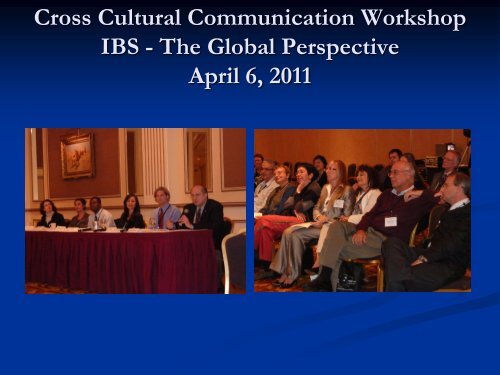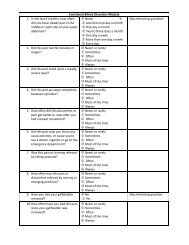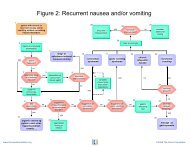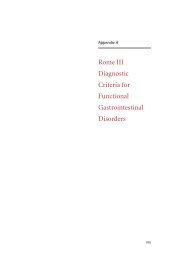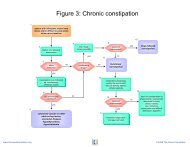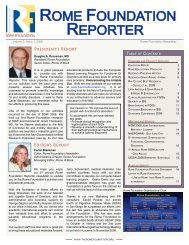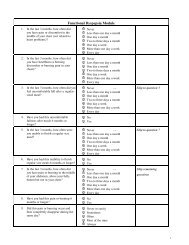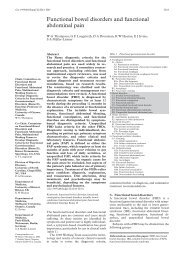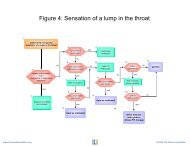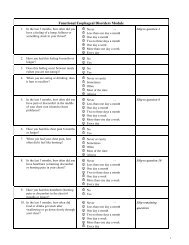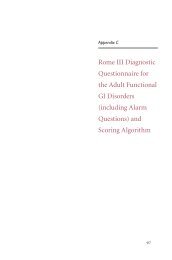Cross Cultural Communication Workshop IBS - The Global ...
Cross Cultural Communication Workshop IBS - The Global ...
Cross Cultural Communication Workshop IBS - The Global ...
- No tags were found...
You also want an ePaper? Increase the reach of your titles
YUMPU automatically turns print PDFs into web optimized ePapers that Google loves.
<strong>Cross</strong> <strong>Cultural</strong> <strong>Communication</strong> <strong>Workshop</strong><strong>IBS</strong> - <strong>The</strong> <strong>Global</strong> PerspectiveApril 6, 2011
<strong>Cross</strong> <strong>Cultural</strong> <strong>Communication</strong>Interactive <strong>The</strong>atre <strong>Workshop</strong>Douglas A. Drossman MD,ModeratorBen Saypol PhD,Moderator
Cast of CharactersVignette #1 – Nigerian PatientDoctor Doug Drossman, MDPatient Ademola Aderoju, MDVignette #2 – Mexican PatientDoctor Lin Chang, MDPatient Carolina Olano, MDVignette #3 – Russian PatientDoctor Lin Chang, MDPatient Albena Halpert, MD
Goals• To highlight culturaldifferences incommunication in amedical setting usinginteractive theater andfacilitated discussion• To apply strategies toobtain more effectiveinteractions consistent withthe patient’s illnessschema/explanatory model
Case History – Last Ten Years• 36 years old• 10 year history of mid to lower generalizedabdominal cramp-like pain -- made worse aftereating.• Frequent stools with some relief of the painafter defecation.• Abdominal bloating and occasional nausea• Symptoms occurred several times a monthwithout loss of ability to work or engage in usualactivities.
Case History – Last 6 Months• Within last six months symptoms became more acute• Severe episodes of abdominal pain and watery diarrhea withfever and chills.• Several episodes of urge incontinence• Patient has cut back on eating and has lost 5 kg.• Saw the family physician 2 weeks ago. No abnormalities.• Blood work including CBC, sedimentation rate, CRP, serumTTG, electrolytes and liver chemistries were normal. Stoolculture for bacterial infection and for Ova and parasites werenegative. A barium enema and CT scan were normal.• Experiencing an inability to carry on usual work and socialactivities. Limited activities outside of the home.
Interactive <strong>The</strong>atre Format• Presentation of Vignette – A condensed medical interview• Facilitated audience discussion – What did you notice in the vignette?(specifically looking at cultural characteristics/communcaition• Check in with Patient – How was your experienced with the Doctor?• Facilitated audience discussion – How can the Doctor improve?• Replay the vignette with Doctor taking the suggestions
Vignette #1 – Nigerian PatientSome cultural characteristics• Strong National Identity (“I’mNigerian”)• Hesitancy to share symptomsof bowel dysfunction(“Heaviness … maybe …probably not…”)• Patient’s mother seek religiousremedy• Abdicates full responsibility forcure to Doctor• Strong negative reaction toantidepressants “I’m notdepressed” (stigma)
Vignette #2 – Mexican Patient• Some cultural characteristics• Calls female Physician“Senorita”• Unique terminology (e.g.“Inflammada” instead ofBloating)• Thinks she must have aamoeba/parasite• Fear of Cancer• Has been to a “Curandero”(Traditional Folk Healer)• Negative reaction toantidepressants (“No soyloca!”)
Vignette #3 – Russian PatientSome cultural characteristics• Energized verbal communication style• Tendency to interrupting – which seemsargumentative, but is not meant to be. Sheis trying to be helpful and give Doctordesired information• Desire for Russian medication, unavailablein States• Wary of American medicine, which shebelieves orders too many tests (“Is thatreally necessary?”)
<strong>The</strong>mes/Strategies• <strong>The</strong>mes• Listen (Active Listening techniques)• Increase empathy• Yes, and instead of yes, but• A few small changes can make a world ofdifference• Strategies• Increase knowledge of characteristics ofpatients from other cultures (helps toknow what might be coming)• Manage physician emotions whendifferences trigger reactions• Avoid dismissing and diminishing patientviews and attitudes• Increase awareness and exploration ofpsycho-social issues – specifically onesthat arise from the patient’s uniqueculture
Resources – Memory Key• Summary of Clinical Session and Case Study• Comparison chart of the three cases(Nigerian, Mexican, Russian)• Extensive info on cultural spects of illnesscommunication (Nigerian, Mexican, Russian,and Chinese• Background reading on:• <strong>Cultural</strong> Competency, <strong>The</strong> Office ofMinority Health• <strong>Cultural</strong> and Health Belief AssessmentTool (CHAT)• Overview of a Chinese Patient Case by ( Dr.Kewin Siah)• National Standards on <strong>Cultural</strong>ly andLinguistically Appropriate Services (CLAS)• Commentary: socio-cultural factors inmedicine and gastrointestinal research byDouglass A. Drossman and Stephen R.Weinland
• Mission: <strong>The</strong>ater Delta usesscripted and improvisationaltheater to promote socialchange in communitiesaround the globe. We believethat when people participatein creating drama on stage,they are more likely toexplore and change personalattitudes and behaviors intheir own lives. Interactive<strong>The</strong>atre Carolina is a program ofCounseling and Wellness Services• http://theaterdelta.com/<strong>The</strong>ater Delta


